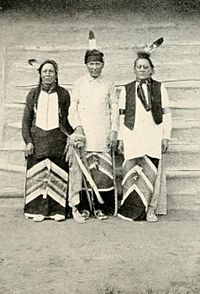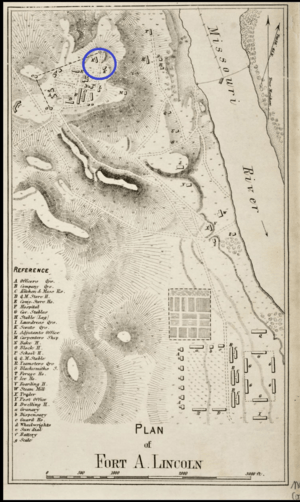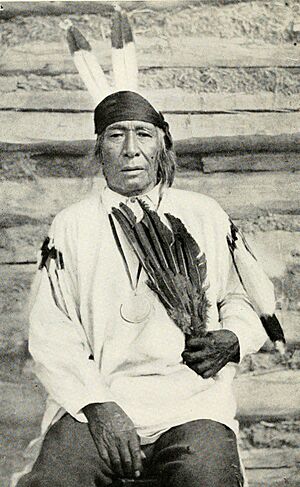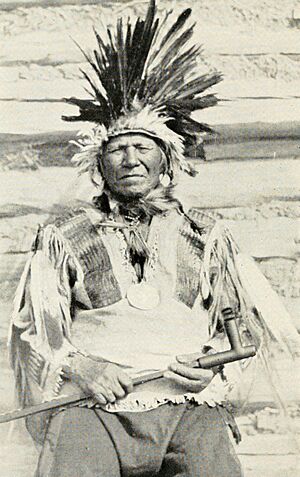Arikara scouts facts for kids
Quick facts for kids Arikara scouts |
|
|---|---|

Former Arikara scouts in the U.S. Army: Red Star (left), Boy Chief (center) and Red Bear (right)
|
|
| Active | 1868 – 1881 |
| Allegiance | |
| Branch | United States Army |
| Type | Indian scouts |
| Garrison/HQ | Fort Stevenson
Fort McKeen Fort Abraham Lincoln (former Fort McKeen) |
| Engagements | Lakota attacks near Fort McKeen |
| Commanders | |
| Notable commanders |
George A. Custer, George Crook, Charles A. Varnum, Alfred Terry |
The Arikara scouts were brave men from the Arikara Nation. They joined the U.S. Army as soldiers. They served at forts in what is now North Dakota. This was between 1868 and 1881.
Scouts usually signed up for six months. They could sign up again if they wanted. Each scout got a uniform, a gun, and food. Their jobs included carrying mail and finding enemies. They often helped the Army in big military missions. Arikara scouts were often the first to fight in battles. This was because they were tasked with finding enemy horses.
The Arikara scouts helped the Army protect survey teams. These teams were working in the Yellowstone area. This happened in the early 1870s. They also fought in the Great Sioux War of 1876. Colonel George Armstrong Custer called them his "most loyal and permanent scouts."
Almost 150 Arikara men joined the Army over time. They served "bravely and honorably." Their service inspires some Arikara people today. Many still choose to join the military.
Contents
Arikara Scouts: A History of Service

Native Americans often joined with white soldiers. They fought against other tribes. For example, in 1823, about 700 Yankton, Yanktonai, and Lakota people helped the U.S. Army. They attacked two Arikara villages in South Dakota. Later, in 1868, Osage scouts found a Cheyenne chief's camp. This led to the Battle of Washita River.
Army commanders on the frontier needed skilled native scouts. These skills were hard for regular soldiers to learn. In 1866, a new law allowed the Army to hire native scouts. They could have up to 1,000 scouts across the country.
Joining the Army and Life at the Forts
In May 1868, the first Arikara scouts joined at Fort Stevenson. The Army wanted to repeat the success of the Pawnee scouts in Nebraska. All the new Arikara recruits came from Chief White Shield's tribal police.
At first, they had infantry rifles. Soon, they also got Spencer repeating carbines. They were paid 40 cents a day if they used their own horse.
More Arikara men later joined at Fort McKeen. Scouts like Strikes Two, Pretty Crow, and Elk Tongue traveled there. They used bull boats for their journey. The Army gave them clothes, including shirts and hats. Some scouts lived at the fort with their families. Arikara men like Forked Horn and Black Fox cooked for the scout unit. Scouts earned $16 a month. They got an extra $12 a month if they rode their own horse.
Important Missions and Battles
Fighting at Fort McKeen
Scouts at Fort McKeen fought the Lakota in 1872. This fort was near the Heart and Missouri Rivers. The Lakota had agreed not to attack anyone after a treaty in 1868. But on August 26, over 100 Sioux attacked. They fought seven soldiers and two scouts outside the fort. The Arikara scouts were killed.
The scouts fought the Lakota again near the fort. This happened on October 2, October 14, and November 3. The Lakota seemed to target the Arikara scouts. Because of these losses, some scouts left the Army. However, Arikara second chief Son of the Star still encouraged men to join.
Protecting Survey Teams
Arikara scouts helped protect teams in 1873. These teams were surveying a railroad route. It went from Bismarck, North Dakota to Bozeman, Montana. The Dakota had attacked workers and soldiers the year before. This was despite a treaty allowing rail building away from their land.
Bloody Knife was a scout and guide for George A. Custer. Custer led the 7th Cavalry Regiment. Bloody Knife helped defend the Cavalry on August 4. They were attacked north of the Yellowstone River. On August 11, hundreds of Lakota attacked again. The Army and scouts fought fiercely.
The Black Hills Expedition, 1874
In 1874, Arikara scouts guided an expedition. It went from Fort Abraham Lincoln to the Black Hills. People were looking for gold. The Black Hills were sacred to the Lakota. A treaty said white people could not go there. Many thought the Lakota would try to stop the expedition. So, soldiers from both the Infantry and Cavalry protected it. George A. Custer was in charge.

The expedition was delayed at the start. News came that a large Lakota war party was attacking Like-a-Fishhook Village. This village was almost 100 miles outside the Lakota reservation. General Philip Sheridan ordered Custer to protect the Arikara. He said to protect them "same as white settlers." But the Lakota attacked on June 13. They killed five Arikara men and one Mandan.
The expedition finally set off. Some young Santee Sioux scouts joined the Arikara. Bloody Knife and Lean Bear were important leaders. Some of the 22 scouts included Enemy Heart, Young Hawk, Goose, and Red Horse. The scouts rode ahead and guarded the sides of the columns. They covered a lot of ground.
One morning, the Arikara found a small Lakota hunting camp. The Arikara scouts rode up and touched a man with their horse whips. This was a way of showing bravery. A few Lakota hunters visited the white camp. Later, a mounted Lakota tried to take a Santee scout's gun. He failed and fled. The pursuing Arikara did not catch him. An old Lakota man was held for a few days, then released.
A man named George Bird Grinnell joined the expedition. He collected birds and fossils. Grinnell rode with Luther H. North. North could speak the Pawnee language. This helped him get along well with the Arikara scouts. Once, a scout went out of his way to offer Grinnell and North water. In camp, scouts watched Grinnell prepare his bird specimens. They talked about the day's events.
The Great Sioux War, 1876
In 1876, Son of the Star told Arikara men about a mission. It was against some Sioux, led by Custer. Young Hawk's father, Forked Horn, joined right away. He said his son would go too. Twenty-three more Arikara men joined. A few days later, Red Bear joined after Son of the Star encouraged him.
During the Little Bighorn campaign, 38 Arikara scouts were involved. They protected base camps. They also rode as messengers. They were part of the front battle line.
The scouts were the first to parade when leaving Fort Abraham Lincoln. On the way to the Yellowstone, scouts guarded the camp from high hills. Those in camp stayed near Custer's tent. Custer often visited with them. Scouts carried mail between the camp and the fort. Red Bear even brought moccasins from their wives for the scouts. Skilled hunters like Strikes Two and Goose earned money. They sold specific cuts of game to the soldiers.
The Cavalry separated from the slower wagon train. This was at the Yellowstone and Powder rivers. The infantry and scouts like Tall Bear guarded the wagons. The field scouts were told to retreat to this position if they were defeated.
On June 21, a scouting party returned. They found a large Lakota trail near the Rosebud River. As they followed the enemy, the scouts sang sacred songs. Custer seemed to encourage them. Red Star said, "Custer had a heart like an Indian… if we ever left out one thing in our ceremonies he always suggested it to us."
Six Crow Indian scouts joined the Cavalry. The area ahead was traditionally Crow land. The Lakota had taken over eastern Crow land. This included the Bighorn River area. They were often attacking the Crow in their camps.
First sergeant Bobtailed-Bull led a group of scouts up the Rosebud River. Red Bear and Soldier led another group on the other side. The mounted troops followed close behind. By the end of the day, they found a recently moved Lakota camp. Signs left by the Lakota showed they were confident for battle.
Bull and Red Star, with other Arikara, followed four Crow scouts. Lieutenant Charles Varnum led the scouts. Charley Reynolds was also with them. The Crow guided the group. This was because they were in their own territory.
The main Army group rested at the Rosebud forks. Custer talked with the remaining scouts. He planned an attack to capture enemy horses. The group rode all night. During breakfast, Bull and Red Star arrived. They had found the enemy camp.
Custer followed Red Star to a hill. The Crow scouts had seen the Lakota camp from there. Custer wanted to wait and surround the camp at night. But the Crow convinced him the Lakota knew the Army was there. So, Custer prepared for a quick attack. The 22 Arikara scouts gathered. Experienced warriors encouraged the younger scouts. They rode ahead and found a lone Lakota tipi. They touched it to show bravery. Custer's troops then caught up. Custer told them off for going against his orders. He wanted them to scatter the enemy horses first.
The fastest scouts followed the Cavalry to the Little Bighorn River. Little Sioux, Red Bear, and 11 scouts crossed the river. They went south of the Lakota camp with Major Reno's troops. Red Star, Boy Chief, and Strikes Two escaped with 28 Lakota horses.
When fighting started, scouts and soldiers dismounted. They formed a line. Bloody Knife joined them. He wore a black handkerchief with blue stars from Custer. He told Young Hawk that horses had been taken from the enemy. Some horses were later taken back by the Lakota. The fight became more intense. During a retreat, some Arikara and two Crow scouts hid in a thick grove. Goose was shot in the hand. The Crow scout White Swan was wounded in his hand and leg. The Lakota tried to force the scouts out. But Custer's attack further north drew the Lakota away.
The scouts left the thicket. They waved a white flag. They headed for a hill where they saw the U.S. troops' flag. They reached Major Marcus Reno's forces. The Lakota pursued them. They learned that Bob-tailed Bull had been killed. Other scouts also reached Reno's troops. Some stayed. Others drove about 40 captured horses toward the supply depot. This was their order if they were defeated.
As night came, four scouts tried to break through the Lakota circle. They carried messages. But they were turned back. Around noon the next day, the Lakota left their camp. Soon after, some went down a ridge. Young Hawk and his father thought they were soldiers. The two scouts returned and reported their location. An officer told them, "Now let us go and look for Custer's body."
On the battlefield, a soldier showed the scouts a dead Arikara in a grove. This was possibly Bloody Knife. The body of Little Brave, who was also killed, was never found. Young Hawk led a pony with the wounded Goose. Goose was on a travois. They went to the steamboat Far West. It was at the mouth of the Little Bighorn River.
The first Arikara scouts reached the Infantry camp at the Powder River. When they told what happened, the soldiers doubted them.
Some scouts continued carrying mail in the following days. Others worked to find the scattered Lakota.
In September, General George Crook and his men needed supplies. They followed a Lakota camp trail south to the Black Hills. Five Arikara scouts went to Fort Abraham Lincoln. They carried an urgent message asking for help. They delivered the telegram in just three days.
Later Years
In 1889, the scouts marched through Bismarck on the 4th of July. In 1912, they formed the United States Volunteer Indian Scouts. Most of them never received a pension, despite promises. To remember Custer, the old scouts wrote and sang a song. This was on Memorial Day in 1917. Some descendants of the scouts still sing the "Custer Song" today.





